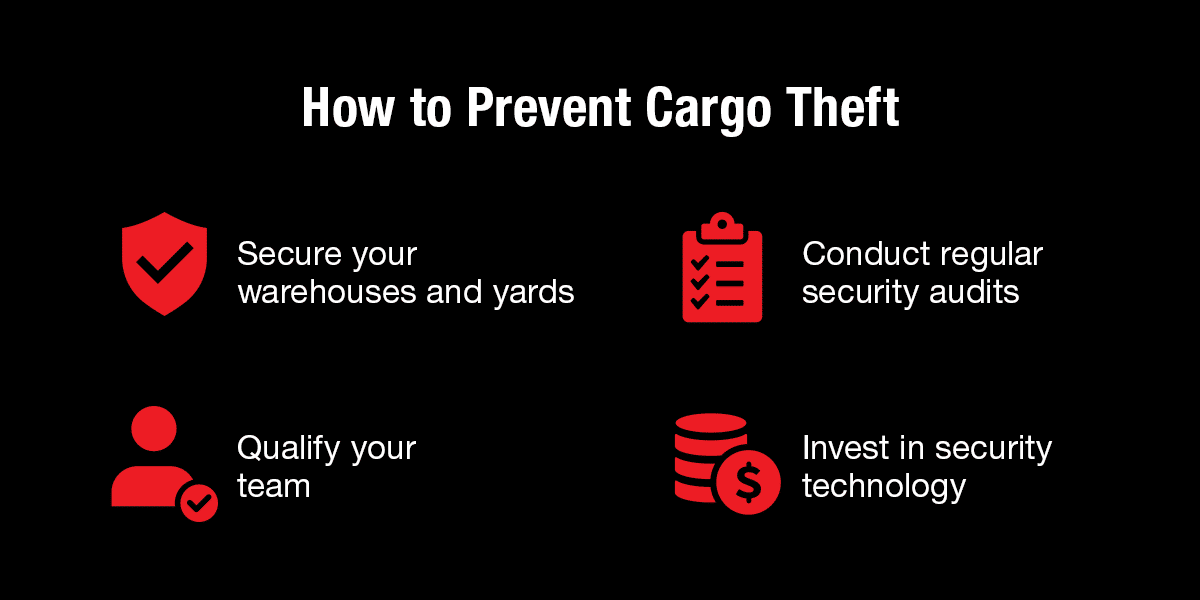Cargo thefts increased by 57% in 2023 — and that number isn’t expected to decline. As crime rates continue to rise, businesses must find more foolproof ways to keep criminals away from tempting opportunities. The cargo transportation industry is already complex. Cargo is always on the move, making getting ahead of thieves even more challenging.
If you’re in the logistics industry, protecting your cargo is your chief priority because there’s so much at stake. Fortunately, while criminals are becoming increasingly creative, tried-and-true security methods may still be your best option. Of course, that depends on the quality of your security.
Read on to discover how criminals pull off cargo theft and what you can do to prevent it.
What Is Cargo Theft?
Cargo theft is the criminal act of stealing cargo, items that are part of a commercial shipment. Cargo can be transported by trucks, trains, aircraft and other commercial means. With cargo theft on the rise, it’s important to be familiar with common strategies that cargo thieves implement. The two main types of cargo theft are straight cargo theft and strategic cargo theft.
1. Straight Cargo Theft
Straight cargo theft is a major threat to commercial businesses such as recycling plants, truck yards, and warehouses. This type of cargo theft is defined as cargo being stolen from where it’s sitting and usually targets products that can quickly be sold on the market. Unattended items on commercial properties are often a target for straight cargo theft. They’re readily available and can be profitable for thieves.
Electric fencing is a great solution for straight cargo theft because it includes a physical, shock and alarm deterrent. Deterring criminals from entering the property in the first place is beneficial in preventing straight cargo theft. It eliminates opportunistic situations for thieves who are looking for an easy payday.
2. Strategic Cargo Theft
Unlike straight cargo theft, strategic theft is more calculated and complicated. This involves deceiving people at various points in the supply chain into turning cargo over to the wrong individuals. Using a fake ID or a fake business to trick carriers, brokers and shippers is a common practice used by commercial burglars to attain costly cargo. Attempting these fictitious pick-ups close to deadlines allows thieves to profit from time constraints and employee errors.
A perimeter security solution with video surveillance can be used to identify commercial burglars in the event of a strategic cargo theft at a business. Holding on to video footage allows a company to review how the criminal got away with commercial robbery to prevent it the next time.
It’s often assumed that criminals are opportunistic with their cargo theft methods. However, criminals are becoming more resourceful and strategic, and they’re planning out crimes in advance. Like modern technology, thieves are smarter than ever and traditional security measures will no longer protect a commercial business.
Understanding the Growing Threat of Cargo Theft
The cargo supply chain is the backbone of trade. It transports goods worldwide in a giant, interconnected web that keeps expanding. As such, thieves have a wealth of options. As more people shop online, the U.S. e-commerce market is expected to generate $1.8 trillion in 2029, up from roughly $1.2 trillion in 2024.
This interconnectedness presents inherent risks, as businesses constantly transport cargo over long distances. Though cargo has always been a target, the differences now are that there’s more of it and that criminals continuously evolve. Modern technology has a role to play in prevention, as it provides real-time insights into cargo shipments and allows you to identify threats early. However, it’s also a double-edged sword since criminals are targeting vulnerable security systems.
If there’s one thing a criminal can spot, it’s vulnerabilities in the supply chain. Cargo stops at many points on its journey. Carriers frequently leave goods at warehouses and parking lots — prime targets for would-be thieves.
The 6 Most Common Methods of Cargo Theft
Given the nature of the modern transportation industry, many cargo thieves have refined their strategies to include:
1. Leakage Operations
Leakage is a term for when criminals slowly and expertly remove goods from shipments. The goal of a leakage operation is for businesses not to notice that anything is missing. This may seem small, but over time, leakage will lead to large losses. Not to mention that once criminals know a company is an easy target, they won’t stop taking advantage.
2. Fictitious Truck Drivers and Pickups
This cargo theft method requires a criminal impersonating a driver who is authorized to pick up cargo. Once cargo is passed off to the wrong person, it’s nearly impossible to recover. This method can involve false paperwork or employees not following protocol to ensure that a driver is who they say they are.
3. Truck Burglaries or Hijackings
This cargo theft term is when a driver takes a break, leaving the truck unattended, and a thief steals the entire truck full of goods. This can be opportunistic, or a truck can be tracked from its departure point and robbed at its first stop. Therefore, it’s recommended that trucks don’t stop for the first 200 miles or four hours of their starting point.
4. False Emergencies or Coerced Stops
A false emergency can be carried out by warning a driver of a false issue with their vehicle. If the driver stops to see what is wrong, thieves will steal the cargo or the whole truck. This situation can be very dangerous for the driver and cause large losses for the company. Drivers are encouraged to check their trucks for issues before departure. They’re also told not to stop for any unplanned reason unless information is coming from a trusted source.
5. Commercial Burglaries
This type of cargo theft occurs at a location where a truck or its cargo is stored. Common locations for a commercial burglary are truck yards, commercial facilities, businesses near railroads and more. Commercial properties are popular sites for criminals to take advantage of because cargo is sitting unattended. This type of cargo theft can easily be prevented by improving security at a commercial site.
6. Driver Involvement
Unfortunately, some cargo theft is due to an inside job. This can mean a staged hijacking or a driver simply turning over cargo to a fellow criminal. Many times, drivers are given a substantial cash payment to pretend to be robbed. This can be avoided by vetting employees and assuring that they’re trustworthy before being trusted with valuable cargo.
The Top Two Targets for Cargo Theft
Cargo thieves are masters at finding the most vulnerable points on the supply chain. They choose what they think are the easiest targets, including:
1. Trucks
Trucks are a major target for criminals. In fact, trucks account for 87% of cargo theft. When drivers stop at a truck stop or warehouse, goods are vulnerable, and security is limited. Many times, thieves lurk at these locations and wait for a truck to be unattended. Thieves are known to track trucks from their starting point and wait for the driver to pull over to steal goods.
2. Commercial Facilities
Commercial facilities often store valuable goods. Commercial yards with assets stored outdoors are vulnerable targets for thieves. A property with weak security gives thieves an opening to come in and steal cargo. Commercial facilities account for 10% of cargo theft, but this can be prevented by installing a layered, integrated security system.
The Most Commonly Stolen Goods
In addition to choosing specific targets, cargo thieves also target some goods more than others. Some of the most frequently stolen products include:
1. Food and Beverage
Food and beverages account for 32% of cargo theft. This category is an easy target because a large volume of food is transported across the country every day and isn’t heavily secured. There is a large market for food sales and thieves will profit from this.
2. Electronics
Electronics are another popular target for thieves, accounting for 22% of cargo theft. Criminals covet electronics because they’re small, easy to conceal, and highly in demand, especially during the holiday season.
3. Alcohol & Tobacco
Alcohol and tobacco account for 10% of total cargo theft. This category is like food and beverages because it’s also transported constantly and in large volumes. Alcohol and tobacco are also in high demand in the markets where criminals sell goods and are therefore easy to unload.
Cargo Theft in the Supply Chain
Supply chains are known for being efficient, and many moving parts work together to ensure that the correct goods are delivered on time worldwide. Unfortunately, many places in the supply chain are vulnerable to criminals. These locations need extra security measures as they store valuable goods and are often at risk.
- Manufacturing plants
- Loading docks
- Rail stations
- Distribution organizations
When Is Cargo Theft Most Likely to Occur?
Labor Day through Christmas is the peak season for cargo theft in the retail and shipping industries. Stores are fully stocked and merchandise is moving in high volumes. While consumers are counting on massive savings, thieves are cashing in on opportunities. They strike trailers and shipments left unattended over the holiday weekends and weeks leading up to Black Friday. And let’s not forget Cyber Monday.
Trucking and logistics companies, warehouses and distribution centers — be wary. Protect your property from theft with a durable and reliable high-security electric fencing and perimeter alarm system from AMAROK.

How to Prevent Cargo Theft
The following tips can boost your cargo theft prevention strategy:
- Secure your warehouses and yards: Thieves are always looking for weaknesses in your transportation strategy. The best time for them to strike is when your cargo is unattended. Erect a secure electric perimeter fence around your parking areas and install integrated surveillance, access control, lighting and intrusion detection. It’s an investment that saves you money and boosts your profitability in the long term.
- Conduct regular security audits: Criminals will continue to find weaknesses in their defenses. Regular threat assessments are an excellent strategy. Bring the experts in to find and fix any vulnerabilities in your physical security.
- Qualify your team: Your team is the first line of defense against criminals. They should have the skills, experience, character and integrity to protect your cargo. Conduct thorough background checks and adhere to a clear code of conduct. Train your staff on security measures so that they know how to recognize and report suspicious activity.
- Invest in security technology: The more insight you have into your cargo’s journey, the better you can protect it. Innovative telematics systems and video surveillance can grant you the necessary visibility.
Protect Your Cargo With AMAROK’s Security Solutions
Your cargo is at its most vulnerable when it’s at rest and unattended, so keeping those goods secure starts with having a safe place to leave them. With AMAROK, you can take a smarter approach to perimeter security.
As an award-winning industry leader in perimeter security, we can help you find the best security solution for your cargo. Our Electric Guard Dog™ Fence is a first-class deterrent. If intruders touch it, they’ll receive a medically safe but highly memorable 7,000-volt shock that stops them in their tracks. We also offer enhancements like access control and flashing lights to deter would-be thieves before they even get close. Find an AMAROK representative today to amp up your cargo security.





